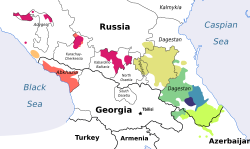|
Tsudaqar language
Tsudaqar (also Tsudakhar, Cudaxar[1]) is a Dargin language, quite different from the literary variety,[2] spoken by over 33,000 people[3] in the Levashinsky and Akushinsky Districts, Novy Kostek in Khasavyurtovsky District, and Novokare in Babayurtovsky District, Dagestan. The village of Tsudakhar was the traditional center. It is considered to be threatened with extinction, being transmitted to children, but not by all families.[2][4] In modern times, work is underway to revitalize Tsudaqar and create an alphabet for the language.[2] RevivalIn response to the declining health and use of the language, speakers have revived the usage of the language, as well as studying and preserving it. An orthography for the language was also devised. Lessons for learning Tsudaqar are available online, and there is a YouTube channel Цудахарское общество which promotes Tsudaqar culture, history and life.[2][5] PhonologyTsudaqar has lost the affricates [d͡ʒ] and [d͡z]. The system of phonemic fortis and lenis has been retained, similar to the system used in Avar–Andic and Lak.[6] Orthography
The letters о, ф, ы, ё, ь are only found in loanwords. ӱ never occurs word-initially and is only found after a consonant. References
External links |
||||||||||||||||||||||||||||||||||||||||||||||||||||||||||||||||||||||||||||||||||||||||||||||



